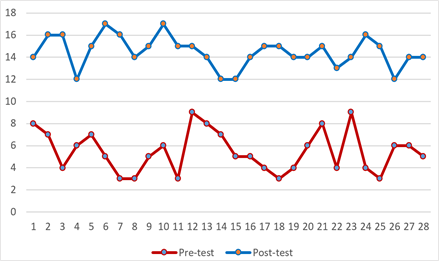Effect of "Boosting my pronunciation" on the suprasegmental elements of accent, pauses and tone of English in language students at a Peruvian university
DOI:
https://doi.org/10.51252/rceyt.v2i1.488Keywords:
learning, items, phonetics, phonology, suprasegmentalAbstract
The objective was to determine the effect that the proposed activity, when applied, has on the suprasegmental elements of accent, pauses and tone in the students of the VI cycle, who are studying the subjects of Phonetics and Phonology of English at a Peruvian university. The research was pre-experimental, where we applied a pre-test, activity development and post-test to a sample of 28 students from a population of 128. The activity demonstrated to have a significant effect on the suprasegmental elements of accent, pauses and tone, since the average of scores of the post-test (14.46) is higher than that of the pre-test (5.46), observing a less dispersed coefficient of variation than in the post test of 12.22 compared to 34.43 of the pre-test. We conclude that the suprasegmental elements of the English language related to accent, pauses, and tone should be studied from the beginning of language acquisition, together with vocabulary and its functionality, to obtain acceptable phonic models that are very close to a native English speaker.
Downloads
References
Aguilar Pérez, I., & Hernández Alipi, M. de los Á. (2022). La motivación como factor en el aprendizaje de idiomas: importancia de las estrategias. Dilemas Contemporáneos: Educación, Política y Valores, 4(3). https://doi.org/10.46377/dilemas.v9i3.3189
Arriaga García, E. P. (2017). Transferencias lingüísticas en los componentes fonético-fonológico y morfosintáctico del lenguaje expresivo en estudiantes del idioma inglés como segunda lengua de segundo grado de primaria en una institución educativa privada bilingüe en el distrito de L [Pontificia Universidad Católica del Perú]. http://hdl.handle.net/20.500.12404/8062
Bentley, J. (2022). Report from TESOL 2014: 1.5 Billion English Learners Worldwide. International TEFL Academy.
Carazas, A. A. R., Cruz, K. M. L. D. La, & Molina, J. F. V. (2021). El impacto del idioma inglés en el comercio internacional. Iberoamerican Business Journal, 4(2). https://doi.org/10.22451/5817.ibj2021.vol4.2.11043
De La Cruz, K. M. L., Gebera, O. W. T., & Copaja, S. J. N. (2022). Application of Gamification in Higher Education in the Teaching of English as a Foreign Language (pp. 323–341). https://doi.org/10.1007/978-981-16-5063-5_27
EF EPI. (2020). Índice EF de nivel de inglés. EF English Proficiency Index.
Esquibel, E., & Román, S. (2018). Relevancia de los rasgos suprasegmentales para la inteligibilidad en futuros profesores, traductores y licenciados en lengua inglesa. Revista Ágora, 3(4), 75–84.
Fernandez Malpartida, W. M. (2021). Language Learning Strategies, English proficiency and Online English Instruction Perception during COVID-19 in Peru. International Journal of Instruction, 14(4), 155–172. https://doi.org/10.29333/iji.2021.14410a
Hamid, M. O., Hardy, I., & Reyes, V. (2019). Test-takers’ perspectives on a global test of English: questions of fairness, justice and validity. Language Testing in Asia, 9(1), 16. https://doi.org/10.1186/s40468-019-0092-9
Jenkins, J. (2000). The Phonology of English as an International Language. Oxford University.
Kochem, T. (2022). Exploring the Connection between Teacher Training and Teacher Cognitions Related to L2 Pronunciation Instruction. TESOL Quarterly, 56(4), 1136–1162. https://doi.org/10.1002/tesq.3095
Li, Y.-T. (2022). How important is English, Mandarin, and Cantonese for getting a job? Exploring employers’ perceptions of linguistic capital in Hong Kong. Chinese Sociological Review, 54(2), 155–177. https://doi.org/10.1080/21620555.2021.1964948
Maschio Gastelaars, L. (2018). Las pausas y la entonación en el aula de español como lengua extranjera: una propuesta didáctica para trabajar la fluidez en el habla de los alumnos [Universitat de Girona]. http://hdl.handle.net/10256/16203
Mata Marroquín, D. B., & García González, M. (2022). Desarrollo de competencias comunicativas en la formación de profesionales de Inglés. Referencia Pedagógica, 10(2), 126–139). https://rrp.cujae.edu.cu/index.php/rrp/article/view/292
MINEDU. (2018). Diccionario de datos. Censo Educativo 2018. Ministerio de Educación del Perú.
Navarro Macedo, R., & Solorzano De La Cruz, K. K. (2015). La técnica LINGUISTIC MIMICRY y su influencia en la producción oral del idioma inglés, componente: ritmo, entonación y stress en los estudiantes del curso de fonética del VI ciclo de la Escuela Académico Profesional de Idiomas de la UNSM-2013 [Universidad Nacional de San Martín]. https://repositorio.unsm.edu.pe/handle/11458/2112
Peltokorpi, V. (2022). The “language” of career success: The effects of English language competence on local employees’ career outcomes in foreign subsidiaries. Journal of International Business Studies. https://doi.org/10.1057/s41267-022-00544-4
Zhang, W. (2022). The Role of Technology-Based Education and Teacher Professional Development in English as a Foreign Language Classes. Frontiers in Psychology, 13. https://doi.org/10.3389/fpsyg.2022.910315

Published
How to Cite
Issue
Section
License
Copyright (c) 2023 Juan Cavero-Egúsquiza-Pezo

This work is licensed under a Creative Commons Attribution 4.0 International License.



